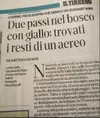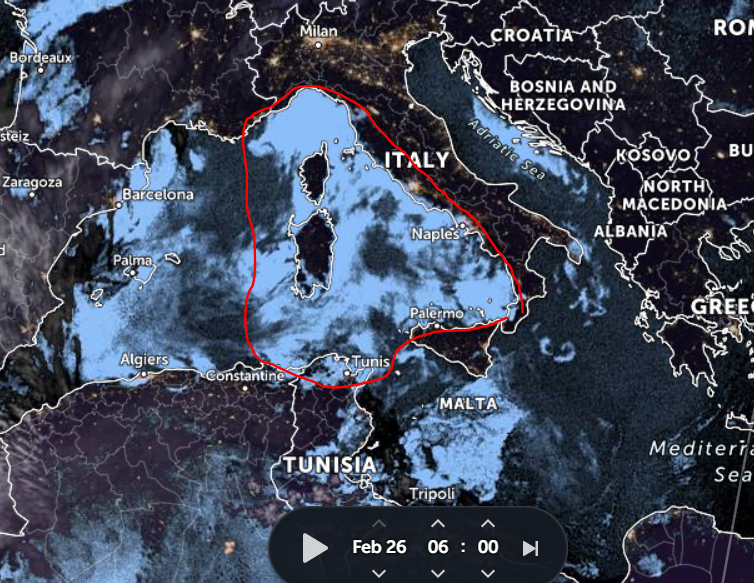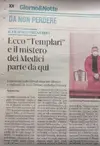-
Like paranormal and time travel?
You are using an out of date browser. It may not display this or other websites correctly.
You should upgrade or use an alternative browser.Captain Leale Martelli - The Odyssey in the Realms of Time
- Thread starter steve69
- Start date
LITTLE DOCTOR
Member
Giunti a questo punto, non sarà certo facile profetizzare quale sarà la strategia che adotterà l’energia dominante, quell’energia divisa tra una “Valle d’Inferno” e una “Valle Benedetta”. Si continuerà a seguire il seducente canto degli Dei, oppure verranno incoraggiati i Santi nel loro pregare?
Divenire templare dal bianco mantello o calarsi in una veste da nero cavaliere? e poi, sarà più saggio dissetarsi alle acque delle antiche sorgenti o scaldarsi al sacro fuoco della fenice appena scoperta? Essere temuto o essere da tutti amato? Vivere in eterno nella più eterna solitudine o lasciare che le proprie membra trovino il giusto riposo nella grazia e nel perdono del signore? Presto o tardi lo sapremo. Lo potremo intuire al momento che vedremo con i nostri occhi da profani quale mano alzerà la coppa e quale mano alzerà la spada d’innanzi ai trenta cavalieri. Sarà la mano di un capitano o di un semplice caporale, o addirittura, come ultimo colpo di coda di un romitone sconfitto, a disporre che ambedue i contendenti si presentino all’ultimo appello. Essi che furono creati dalla musica, dal colore e dall’intenso calore, possano in fine dissolversi come neve al sole, come sogno al risveglio, come amore nel tradimento. Ho tentato di fermare la mia mano mentre scrivevo, di bloccare la mente in modo che i pensieri non giungessero alla mano, ma non ci sono riuscito. Non posso esimermi di proseguire il mio percorso e svolgere il mio compito. Spero tuttavia che questa profezia non trovi compimento. Altre profezie meno nefaste mi rendono felice e speranzoso, specialmente il ritrovamento delle sacre reliquie nella chiesa mi riempie di gioia. La loro esposizione al pubblico è un fatto eccezionale, la loro esistenza era pressoché sconosciuta, in pochi sapevano della loro presenza presso la chiesa della Valle Benedetta, uno di questi era il grande artista Voltolino Fontani, che pur sapendo, volle mantenere il segreto, ma cercò di trasferire il suo sapere in un dipinto, cosa che era sua abitudine fare. Egli creò un’opera da donare alla chiesa dal titolo: “San Francesco e il poverello” perché sapeva della presenza della reliquia di San Francesco presso la chiesa. Il dipinto è tuttora esposto all’interno della chiesa della Valle Benedetta.
(English)
Having reached this point, it will certainly not be easy to prophesy what will be the strategy that the dominant energy will adopt, that energy divided between a "Valley of Hell" and a "Blessed Valley". Will we continue to follow the seductive song of the Gods, or will the Saints be encouraged in their prayers? Becoming a white-cloaked Templar or slipping into a black knight's robe? and then, will it be wiser to quench your thirst at the waters of the ancient springs or warm yourself at the sacred fire of the newly discovered phoenix? To be feared or loved by all? To live forever in the most eternal solitude or to let one's limbs find the right rest in the grace and forgiveness of the Lord? Sooner or later we will know. We will be able to guess it when we see with our profane eyes which hand will raise the cup and which hand will raise the sword in front of the thirty knights. It will be the hand of a captain or a simple corporal, or even, as the last blow of the tail of a defeated hermit, to order that both contenders present themselves at the last roll call. They who were created by music, color and intense heat, may they finally dissolve like snow in the sun, like a dream in awakening, like love in betrayal. I tried to stop my hand as I wrote, to stop my mind so that thoughts didn't reach my hand, but I couldn't. I cannot fail to continue my journey and carry out my task. However, I hope that this prophecy will not be fulfilled. Other less nefarious prophecies make me happy and hopeful, especially the discovery of the sacred relics in the church fills me with joy. Their exposure to the public is an exceptional fact, their existence was almost unknown, few knew of their presence at the church of the Valle Benedetta, one of these was the great artist Voltolino Fontani, who despite knowing, wanted to keep the secret, but he tried to transfer his knowledge into a painting, which was his habit to do. He created a work to donate to the church entitled: "San Francesco and the poor man" because he knew of the presence of the relic of San Francesco in the church. The painting is still exhibited inside the church of Valle Benedetta.Last edited by a moderator:Un articolo interessante e' saltato fuori oggi. Parla di un aereoplano caduto in Valle Benedetta decenni fa'.
Il quotidiano e' il Tirreno di Livorno.
Nelle vicinanze e' presente una necropoli protostorica, cosi' riporta l'articolo.
Pare che a Valle Benedetta ci sia ogni cosa: necropoli, foreste pietrificate, tutto in una valle inferno............
Questo convalida ancora una volta la narrazione di LD. Ecco il link:
TOURIST
(English)
An interesting article popped up today. Talk about a plane that crashed in Valle Benedetta decades ago. The newspaper is the Tirreno di Livorno. Nearby there is a protohistoric necropolis, according to the article. It seems that in Valle Benedetta there is everything: necropolises, petrified forests, all in an infernal valley............ This once again validates LD's narrative. Here is the link: TOURIST

Livorno, nel bosco spunta il relitto di un aereo precipitato 40 anni fa
Ma come è possibile che a distanza di così tanto tempo quella carcassa sia ancora là dentro? iltirreno.gelocal.it
iltirreno.gelocal.it

 Last edited by a moderator:
Last edited by a moderator:LITTLE DOCTOR
Member
Un’ingarbugliata matassa, ecco come descriveva in una sua poesia Leale Martelli la propria esperienza alla Valle Benedetta. Una matassa che poi si fece filo di seta che scorreva fluido tra le dita dal momento che tutto gli parve chiaro. Dopo aver usato lo specchio del Romitone Leale riuscì a comprendere l’arcano mistero. Quello specchio appartenuto ad una Dea felina e che al suo interno albergava un fedele custode e devoto servitore che agli occhi degli umani appariva come un Romitone. Questo Romitone accolse il capitano mostrandolo alla sua padrona e mostrò pure, attraverso vari specchi collocati nella sala, lo scorrere di immagini della vita già vissuta del capitano. Subito la Dea sembrò gradire tali immagini, soprattutto quelle che mostravano Leale sfoggiare il suo coraggio e comportarsi con onorevole atteggiamento durante ogni battaglia anche nei confronti del nemico. Nella guerra civile spagnola egli impedì che un prigioniero basco venisse per rappresaglia travolto dai cingoli di un carro armato italiano facendo scudo con il proprio corpo. Dalla guerra civile spagnola a quella italiana il passo fu breve, ma il comportamento del capitano non cambiò. Tornato a Firenze per cercare di mettere in salvo i suoi ex camerati nelle frenetiche ore che videro la capitolazione della città, egli guidò un manipolo di fascisti rimasti a difendere Firenze in un tunnel segreto che passa sotto il fiume Arno, che in tempi antichi era conosciuto da pochi, fra questi la famiglia Martelli. Il capitano, braccato dai partigiani, riuscì a portare in salvo i suoi uomini attraversando il tunnel segreto. Prima di imboccare il tunnel uno dei suoi uomini, un moschettiere del Duce, certo “Attilio” fu colpito a morte da un proiettile partigiano, ma Leale se lo caricò in spalla e lo portò via per evitare che il corpo cadesse nelle mani del nemico. Lasciò il corpo priva di vita all’interno del tunnel, sicuro che nessuno lo avrebbe mai trovato. Ma dopo alcuni anni, a metà degli anni ‘50, alcuni bambini giocando trovarono l’ingresso del tunnel e pure il corpo perfettamente conservato del moschettiere del duce. In seguito le autorità rimossero il corpo e chiusero definitivamente il tunnel. Grazie all’azione del capitano 10 uomini trovarono la salvezza riuscendo a passare sotto il fiume Arno per sbucare poi presso la torre della Zecca. La burrascosa vita del capitano stava sempre più suscitando interesse nella Dea felina, che sotto forma di gatta osservava le immagini accanto al Romitone, il quale, nel frattempo, aveva assunto le sembianze di un monaco incappucciato. Altre immagini passavano attraverso lo specchio e sempre raffiguravano il capitano impegnato in azioni di guerra, in particolare le imprese di Como alla fine di aprile del 1945, il giorno dopo la fine della guerra, all’altezza di via Milano. Una colonna di mezzi tedeschi sfrecciava veloce nel tentativo di lasciare l’Italia, ad un certo momento un’auto militare si sfila dal convoglio e accosta lungo la strada, a bordo si trova il capitano Leale Martelli e alla guida un ufficiale delle SS incaricato di portare il capitano fiorentino in Svizzera. L’ufficiale che scortava Leale Martelli decise di staccarsi dal convoglio e proseguire in solitudine verso la Svizzera. Mentre l’auto era ferma sul marciapiede venne avvicinata da un partigiano che imbracciava un mitra tedesco, evidentemente sottratto ad un soldato deceduto. Il giovane puntò il mitra verso il capitano, il quale, con un agile mossa, riuscì a deviare la traiettoria colpendo il mitra con un calcio. Il capitano raccolse il mitra caduto a terra e prese la mira per uccidere l’aggressore, ma accorgendosi che il partigiano era solo un adolescente impaurito, decise di risparmiare la sua vita e lo lasciò andare. Purtroppo il colpo partito dal mitra andò a colpire una donna che si era appena affacciata alla finestra… ma questa è un’altra storia….
(English)
A tangled skein, this is how Leale Martelli described his experience in the Blessed Valley in one of his poems. A skein that then became silk thread that flowed fluidly between his fingers since everything seemed clear to him. After using the Loyal Romitone's mirror she was able to understand the arcane mystery. That mirror belonged to a feline goddess and that inside it housed a faithful guardian and devoted servant who in the eyes of humans appeared as a Romitone. This Romitone welcomed the captain showing him to his mistress and also showed, through various mirrors placed in the room, the flow of images of the life already lived by the captain. Immediately the Goddess seemed to like these images, especially those that showed Butler showing off her courage and behaving with an honorable attitude during every battle even towards the enemy. In the Spanish Civil War he prevented a Basque prisoner from being run over by the tracks of an Italian tank in retaliation by shielding himself with his body. From the Spanish civil war to the Italian one, the step was short, but the captain's behavior did not change. Returning to Florence to try to rescue his former comrades in the frantic hours that saw the capitulation of the city, he led a handful of remaining Fascists to defend Florence in a secret tunnel that passes under the Arno River, which in ancient times was known by a few, among them the Martelli family. The captain, hunted down by the partisans, managed to bring his men to safety by crossing the secret tunnel. Before entering the tunnel, one of his men, a musketeer of the Duce, a certain "Attilio" was fatally shot by a partisan bullet, but Leale loaded him on his shoulder and carried him away to prevent the body from falling into enemy hands . He left the lifeless body inside the tunnel, sure that no one would ever find him. But after a few years, in the mid-1950s, some children while playing found the entrance to the tunnel and also the perfectly preserved body of the Duce's musketeer. The authorities later removed the body and permanently closed the tunnel. Thanks to the action of the captain, 10 men found safety by managing to pass under the Arno river and then emerge at the tower of the Mint. The stormy life of the captain was increasingly arousing interest in the feline goddess, who in the form of a cat observed the images next to the Romitone, who, in the meantime, had assumed the appearance of a hooded monk. Other images passed through the mirror and always depicted the captain engaged in war actions, in particular the enterprises of Como at the end of April 1945, the day after the end of the war, at via Milano. A column of German vehicles was speeding by in an attempt to leave Italy, at a certain moment a military car slips out of the convoy and pulls over along the road, Captain Leale Martelli is on board and an SS officer in charge of take the Florentine captain to Switzerland. The officer escorting Leale Martelli decided to detach himself from the convoy and continue alone towards Switzerland. While the car was standing on the sidewalk, it was approached by a partisan holding a German machine gun, evidently stolen from a deceased soldier. The young man aimed the machine gun at the captain, who, with an agile move, managed to divert the trajectory by kicking the machine gun. The captain picked up the machine gun that fell to the ground and took aim to kill the attacker, but realizing that the partisan was just a scared teenager, he decided to spare his life and let him go. Unfortunately the shot from the machine gun hit a woman who had just looked out the window... but that's another story....Last edited by a moderator:Salve, ho trovato questa notizia relativa alle nebbie che negli ultimi giorni interessano Livorno e la costa tirrenica fino giu' a Napoli.
So che in questi giorni Livorno e' investita da questa particolare nebbia che non si dissolve velocemente dopo che il sole e' sorto, ma occorrono alcune ore, cosa insolita per questa citta' - vale la pena fare una connessione con quanto LD ha scritto al riguardo della improvvisa nebbia che si crea in alcuni momenti - ecco il link :
TOURIST
(English)
Hi, I found this news relating to the fogs that have affected Livorno and the Tyrrhenian coast as far as Naples in recent days. I know that these days Livorno is hit by this particular fog that doesn't dissolve quickly after the sun has risen, but it takes a few hours, which is unusual for this city - it is worth making a connection with what LD wrote to about the sudden fog that is created in some moments - here is the link : TOURIST
Una coltre grigia e maleodorante sta avvolgendo parte dell'Italia
Nebbia chimica a Napoliterrarealtime.blogspot.com


 Last edited by a moderator:Stando a quelle immagini, dove vivo io ( Calabria giusto sullo stretto ) , dovrei avere gia' visto o sentito qualcosa, ma assolutamente qui non e' succeso di strano
Last edited by a moderator:Stando a quelle immagini, dove vivo io ( Calabria giusto sullo stretto ) , dovrei avere gia' visto o sentito qualcosa, ma assolutamente qui non e' succeso di strano
According to those images, where I live (Calabria right on the strait), I should have already seen or heard something, but absolutely nothing strange happened hereLast edited by a moderator:Hi, just to get further images and video about the very strange fog that has arisen in Livorno during these last days.
TOURIST
Livorno "abbracciata" dalla nebbia: lo spettacolare video dal drone
Lo spettacolo nello spettacolo: ecco Livorno nella nebbia visto con le immagini dal drone dell'azienda livornese Drone Activity. Riprese davvero mozzafiato che potete ammirare anche sulla pagina Facebook Livorno Sopra(video Drone Activity) video.iltirreno.gelocal.it
video.iltirreno.gelocal.it
 Found out a documentary film just relating to this story:
Found out a documentary film just relating to this story:
TOURIST

Watch Templars il Mistero dei Medici Online | Vimeo On Demand
"Templars il Mistero dei Medici" , diretto da Luca Centoni, è il secondo capitolo della saga ed il sequel di "Templars i Segreti del Codice…vimeo.com
Hi everybody! I found this news paper's article that may be the same episode LD talked about in his last post....take a look and tell me what do U think about it....
Angelina, uccisa alla finestra il 26 aprile 1945 «Chi sa qualcosa, ci aiuti»
-
This site uses cookies to help personalise content, tailor your experience and to keep you logged in if you register.
By continuing to use this site, you are consenting to our use of cookies.



